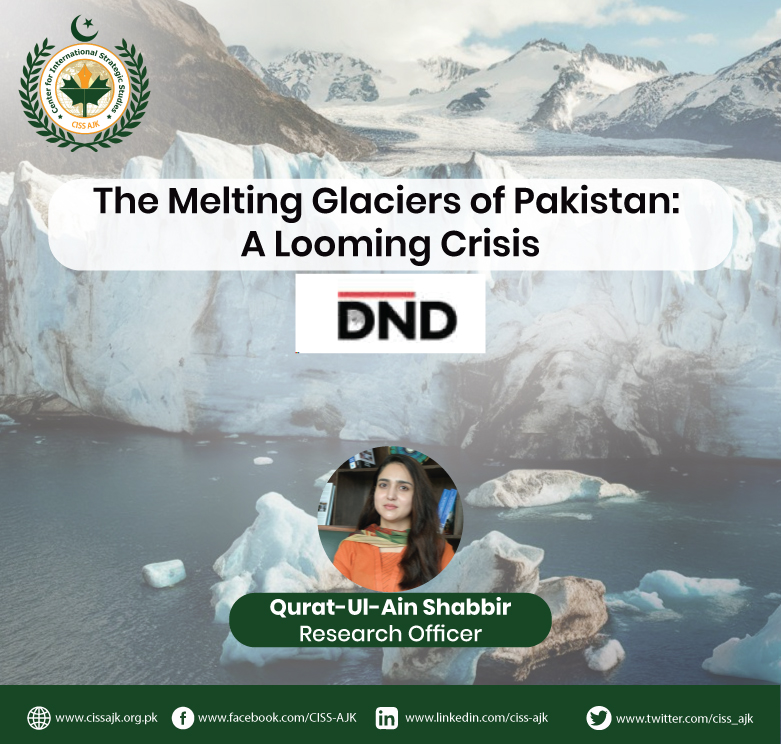Pakistan, home to over 7,000 glaciers, holds the largest concentration of glacial ice outside the Polar Regions. This unique geographical feature places the country at the forefront of climate change discussions, particularly given its high vulnerability to extreme weather events. According to the Global Climate Risk Index by Germanwatch, Pakistan ranks as the eighth most vulnerable country to climate change. In recent years, Pakistan has experienced an increase in the frequency and intensity of extreme weather events. Heatwaves, with temperatures soaring to 50 degrees Celsius (122 Fahrenheit), have become more common, disrupting daily life and posing serious health risks. Additionally, the country has faced devastating floods and droughts, leading to significant human and economic losses. Thousands of people have been killed or displaced, and vital infrastructure has been destroyed, crippling livelihoods and hindering development.
The consequences of this accelerated glacier melt are profound. As glaciers shrink, the risk of flooding increases. Melting glaciers are one of the most visible and direct consequences of the climate crisis. Pakistan, home to the largest number of glaciers outside the Polar Regions, is particularly affected. Instead of preserving these majestic natural wonders, Pakistan is witnessing their rapid melt.
One particularly dangerous consequence of melting glaciers is the formation of high-elevation lakes in the mountains. These lakes, often dammed by glacial ice, can rapidly expand due to increased runoff. If the ice dams break, it can lead to a catastrophic event known as a “glacial lake outburst flood,” causing extreme and sudden flooding. These breaches are extremely dangerous. In April 2022, one of the hottest months on record in Pakistan, a glacial lake in Hunza’s district village Hassanbad, near Mount Shishpar, burst. The lake likely expanded too quickly with melted ice, leading to the rupture. The resulting floodwater inundated a village in northern Pakistan and swept away the Hassanabad Bridge, a major tourist attraction in the area.
This melting trend poses significant threats to Pakistan, which is already one of the most vulnerable countries to climate change. As the planet warms, Pakistan will become increasingly susceptible to flooding. This is a harsh reality for a nation responsible for only a tiny fraction of global greenhouse gas emissions, highlighting how the actions of major polluters can have far-reaching impacts. Like many other countries, Pakistan will bear a disproportionate burden of climate change in the years to come.
However, global warming is not the only factor contributing to this looming crisis. Negligence by Pakistani authorities and harmful human activities are exacerbating the situation. Lax environmental standards magnify the danger, as the population living near glaciers dumps garbage and sewage directly into streams that feed the rivers. These rivers account for about 75 percent of the stored-water supply in a country of at least 180 million people, threatening water and food security.
Deforestation is also a significant contributor to this crisis. Tree roots stabilize the ground that the glaciers are anchored to, and Pakistan has retained just 2 to 5 percent of its tree cover. This loss of forest cover destabilizes the soil and increases the likelihood of landslides and other forms of environmental degradation.
This cycle of environmental degradation and poor governance worsens the impact of climate change, creating a vicious cycle of hardship for Pakistan. The combination of inadequate environmental policies, human negligence, and the overarching threat of global warming intensifies the country’s vulnerability, leading to increasingly severe consequences for its people and ecosystems.
 The author Qurat-Ul-Ain Shabbir is a research officer at the Center for International Strategic Studies (CISS) AJK. Currently, she is pursuing her Ph.D. degree in DSS from Quaid-i-Azam University. Her areas of interest include comprehensive security and conflict analysis. She can be approached at: annieshabbir341@yahoo.com
The author Qurat-Ul-Ain Shabbir is a research officer at the Center for International Strategic Studies (CISS) AJK. Currently, she is pursuing her Ph.D. degree in DSS from Quaid-i-Azam University. Her areas of interest include comprehensive security and conflict analysis. She can be approached at: annieshabbir341@yahoo.com
Disclaimer:
The views and opinions expressed in this article/Opinion/Comment are those of the author and do not necessarily reflect the official policy or position of the DND Thought Center and Dispatch News Desk (DND). Assumptions made within the analysis are not reflective of the position of the DND Thought Center and Dispatch News Desk News Agency.



